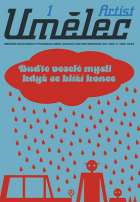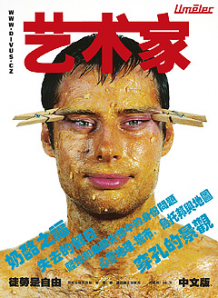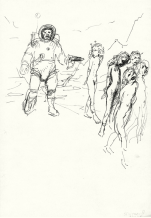| Umělec magazine 1998/1 >> New York | List of all editions. | ||||||||||||
|
|||||||||||||
New YorkUmělec magazine 1998/101.01.1998 Tomáš Pospiszyl | new york | en cs |
|||||||||||||
|
Czech magazines and newspapers reporting on art developed a brand new and peculiar style of journalism a few years ago - a travel report. The writer arrives to a city, goes to see twelve exhibitions and three museums or a whole art fair. Perhaps in the evening, there will be time to attend an opening and then it’s time again to get on the packed morning bus or plane back home. What follows is a list of impressions written with the help of postcards and catalogues on sale.
Perhaps, this style should be called tourist criticism. It is typical for its laid-back holiday atmosphere, most of the described pieces are great, exotic and pleasant just like southern sun and sandy beaches. I know how unfair this judgment is to those who have been saving money for months in order to see a few exhibitions abroad. For me, the problem starts at the point when an analysis turns into a mere list lacking placement of the works into a context of either international or local art. It is more useful to write in-depth articles on what’s going on in a domestic scene rather than just saying that somewhere abroad something exists. It would seem more valuable to ask a critic who lives in a foreign city to write a piece and have that translated. Also, stupid writing about art remains stupid whether the subject matter is Australia or the North Bohemian city of Ústí nad Labem. Tourist criticism, on the other hand, is not absolutely of no value even though we learn more about Czech art and Czech way of looking at things rather than foreign art. Having written this, I prepared the reader for my own tourist experience. After a few months of living in Prague, I visited New York at the beginning of November and I really felt like travelling through my own past. I was to go through a roller-coaster of endless phonecalls and meetings with friends but I have to admit that all the gossip about who and how seemed a bit uninteresting from my Prague perspective. The weather was fine, the food delicious and I fortunately managed to see a few interesting exhibitions, memorials and art in general. I will mention three of them. I. We were standing on a roof of a large building. The wind was strong and a silhouette of Manhattan skyline was visible in the background. My right ear was still numb after I had placed it on a two-meter-tall metal column on a covered terrace. Some secret mechanism inside or a malicious viewer hit it, the sound of it nearly kicked me off. The most brave of us was climbing a long, narrow metal ladder up to what seemed to be another roof level. “Is there anything up there?“ we tried to shout because we didn’t quite feel like climbing. I have already knocked my ankle in one of the dark corridors of the building and I had a feeling that some security men would soon kick us out. “I can’t see anything,“ came a quite voice from above, “... wait a minute..., come up here, this must be Bruce Nauman.“ After years of reconstruction, the P.S.1 Museum, center for contemporary art in Long Island City, was finally open. Just two subway stops from Manhattan, this former school building was turned into an unusual alternative space for showing art which is possible to see in larger and famous central museums but having visited P.S.1 you will consider them more sterile than an operation hall. No security guard would kick us out from the roof, they would perhaps just warn us about the danger and politely ask whether we are ready to run the risk of wounding ourselves. The visitor could enter any space of the building which was open (I found only one office locked). Art was indeed everywhere from corridors, basements, atticks to bathrooms. Right at the entrance, the viewer’s attention is grabbed by miniature Pipiloti Rist screaming from the floor and burning in lava on a few centimeters wide screen inserted to the floor. Next to a former coal storage in the basement is Robert Ryman (the insurance people must have been fainting when they saw this), and the attick shows Richard Serra also in the floor. There was not much money for reconstruction which makes the building look nothing like a museum. It is more of an old school tranformed into an exhibition space. Some of the classrooms and cloak rooms were kept for art interventions. In addition to art works made specifically for the space, the building also includes a few more traditionally conceived exhibition spaces where exhibitions may take turns. There is also a dozen studios for artist residents from around the world. Despite clear optimism of the first week after its opening, the institution is burdened with a shadow of unstable future. The P.S.1 management has so far failed to clearly define its future program and funding. Perhaps this question is not important for P.S.1 in contrast to even the largest institutions in Prague as it is located in a city with thousands of artist while employing only six people and having Bruce Nauman on the roof. II. Upon entering Jack Tilton Gallery, the scale of exhibited works immediately revealed that they were not made by an American artist. Francis Alys comes from Belgium but chose to live in Mexico. He has not exhibited his work outside Mexico very much. His art reaches several artistic disciplines, combining European traditions and Mexican folk art. The entire gallery seemed to be filled with various small, even miniature objects which composed a story told in many sentences, compared to which American art looks like a one-line slogan. One of the walls was covered with tiny pieces of paper with lonely persons and objects drawn on them. When the viewer got too close to the fragile drawings, the pieces of paper were being moved by breath. The silent solitude of Alys’ stories is further emphasized by literal breakaway from the surrounding world. A video showing a shephard leading a number of dumb sheep in a circle around a pole so that the last one is stepping on the paws of the first one is funny, political and easy to understand everywhere sheep are grown. In the middle of the gallery, was a glass filled with water standing upside down. Physical laws held the water surrounding a tiny figure of a sitting man. Lifting the glass and liberating the little being from his loneliness would mean depriving him of his maternal water. So we’re left to watch what he’s doing in his little fish-tank. A close look reveals it’s not nice at all. The opposite wall showed two rows of a series of square paintings which remind of Viktor Pivovarov with their sensitivity, expression and tale-like content. Both Mexican and Central European and Russian cultures are far more based on word and literature then image oriented North American culture which does not imply that neither of those approaches is more valuable than the other. III. I have never liked Matthew Barney’s work. Probably I´m not enough of a snob, an elitist or an intellectual but I’ve never understood the meaning of Barney’s films and photographs. His works have merely inspired my thoughts that not only is the king naked but has goat ears glued to his head. I have always admired the enthusiasts who were able to see Cremaster 4 ten times in a row and keep on discovering all the hidden details like the one with the dancers who remind of molecular structure of microbes when looked at from above. I guess I don’t have a feeling for art which is an illustration of a chemistry or a biology book. Barney is a true art comet. As soon as he finished his sculpture studies, his gallerist started lobbying his way to art magazines, Documenta 1992 and Whitney Biennial a year later. For the past five years, his cryptical and unabridged films, performances and photographs have helped to shape the whole decade without anyone being able to clearly say why. Response to his work is ambiguous: from celebrations of new revolution in sculpture to accusations of Barney’s sexual deviation (applying certain proportions, both may be true). Recently finished Cremaster 5, however, is not boring at all providing me a certain key to Barney’s previous work which is a complex combination of performance, sculpture, video and architecture. It is an ambitious and successful attempt at creating a brand new, independent and artifficial world complete with its own symbols, unpenetratable mythology and its own rules which are not always in accord with normal human logic. Cremaster 5 is without a doubt a beautiful and technically well done film. The camera and editing are close to normal classic commercial films while lacking repetitive and lengthy features so typical for previous parts of this series. A 50-minute opera in Hungarian, Cremaster 5 was shot in Budapest locations: an opera, a bridge and Turkish baths. Unfortunately, it is impossible to even hint on the story which finishes with unclear but vast tragedy.
01.01.1998
Recommended articles
|
|||||||||||||
|
04.02.2020 10:17
Letošní 50. ročník Art Basel přilákal celkem 93 000 návštěvníků a sběratelů z 80 zemí světa. 290 prémiových galerií představilo umělecká díla od počátku 20. století až po současnost. Hlavní sektor přehlídky, tradičně v prvním patře výstavního prostoru, představil 232 předních galerií z celého světa nabízející umění nejvyšší kvality. Veletrh ukázal vzestupný trend prodeje prostřednictvím galerií jak soukromým sbírkám, tak i institucím. Kromě hlavního veletrhu stály za návštěvu i ty přidružené: Volta, Liste a Photo Basel, k tomu doprovodné programy a výstavy v místních institucích, které kvalitou daleko přesahují hranice města tj. Kunsthalle Basel, Kunstmuseum, Tinguely muzeum nebo Fondation Beyeler.
|






























 We Are Rising National Gallery For You! Go to Kyjov by Krásná Lípa no.37.
We Are Rising National Gallery For You! Go to Kyjov by Krásná Lípa no.37.
Comments
There are currently no comments.Add new comment